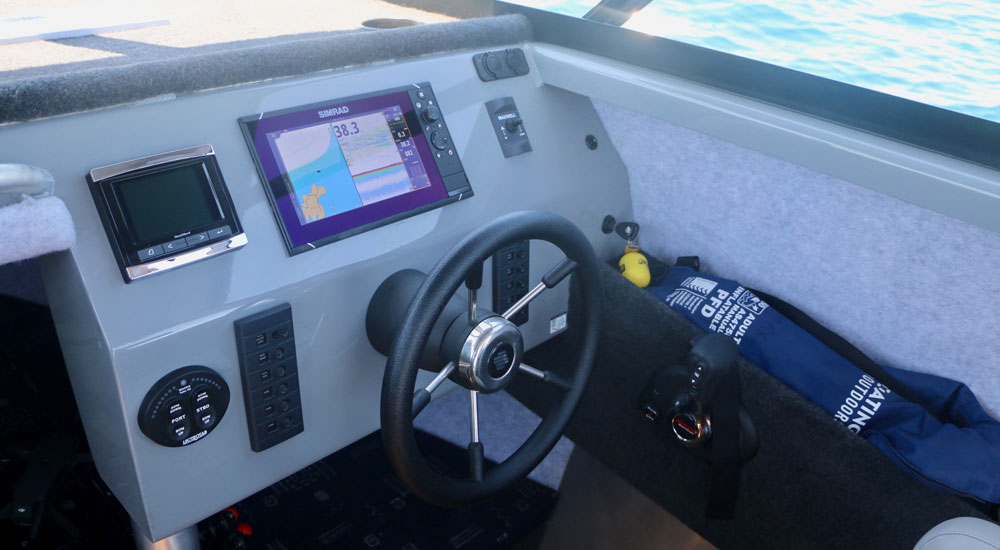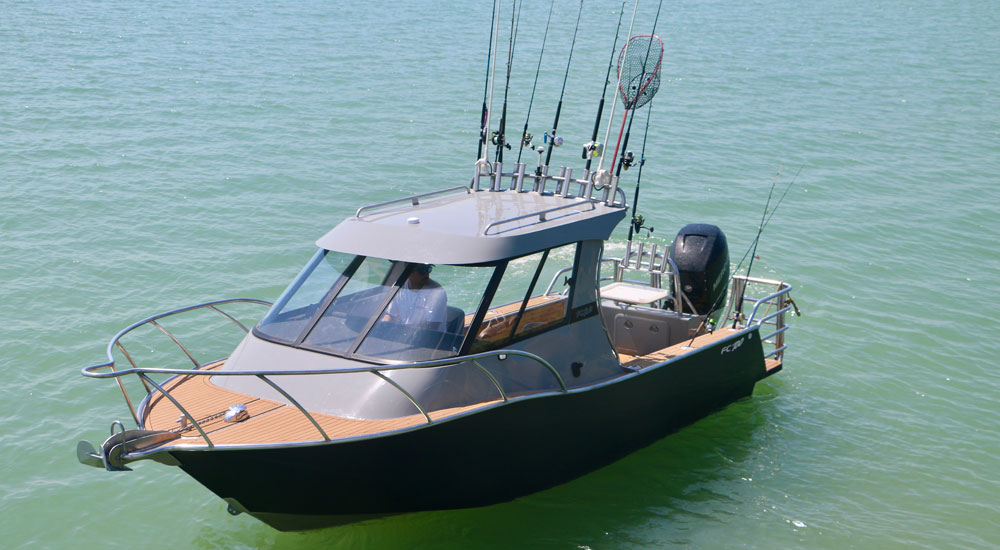With a growing cult following, FC Boats appears to be the go to brand on the market at the moment. Freddy Foote checks out the FC700, to see why the brand has become so popular with kiwi boaties.
In just a short time frame, the growth of the FC Boats brand has been quite rapid. The company started with a small range of versatile and tough runabouts, and ever since it has grown to cabin boats, centre consoles and the larger hardtops as we see here with this FC700 model.
Currently, the FC700 is the largest model in the FC Boats range, and sits above the FC620 HT – the only other hardtop currently available.

Stable Ride
A number of brands experiment with stability systems, each doing it in slightly different ways to achieve the same thing. The FC700 has two stability systems built into the hull design. Aft there is a flooding keel, which fills with water when the boat is at rest, making the craft ultra stable. One you put the throttle down, the water quickly drains out.
Add to that; there is a controllable ballast system. Next to the helm, there is a ballast lever that enables the skipper to bring the desired amount of forward ballast (about 200 litres) on board. To fill, you open the valve, put the boat in reverse and within a matter of seconds you have taken on the chosen amount of water ballast. This can be observed by looking through the viewing window at the base of the valve control, or by simply seeing the water come out of the breather pipe in the bow. Lock the ballast in place and away you go. Fantastic in rougher sea conditions.

All Rounder
The FC700 is a boat that will appeal to a wide variety of users; the serious fishers into game fishing or soft baiting, to those who want a big roomy boat with enough space to store all the dive gear and the ability to get out to a favourite spot quickly and comfortably. It’s available in either open hardtop, or an enclosed version.
Where the FC700 is different to its counterparts is the configuration and use of space. The extended gunnels give an extremely dry boat and also allow you to walk around the cabin to access the flat front bow area for an extra casting/fishing area.
On our test day, Max Christensen spent most of his time up there casting baits trying to lure in a couple of big fish. There are not too many other boats on the market in a hardtop configuration that give you the ability to cast from the foredeck.
Moving aft, across the stern there is a healthy sized boarding platform on either side of the outboard pod. Both sides of the transom are caged and a section of the cage can be dropped down to allow access in and out of the boat. Neat feature. Also means, if you want to bring a big fish on-board you can do so via the port or starboard walk-thru.

Once in the cockpit, one of the first things you notice is the passive live bait tank, which is located low down on the floor in the centre of the transom. Passive means that it fills itself when at rest, and water can be kept locked in until you choose to discharge. The system works well, and we kept a number of live baits in there swimming around throughout the day.
The cockpit is fairly sizeable, with long side shelves running part way under the coamings. Rod storage options can be found at the bait station, in the coamings or in the rocket launcher above. Incidentally the rocket launcher can hold 13 rods.
The cockpit floor is finished in teak toned SeaDek, which is carried on throughout the boat. Also available in a grey colour, it is really nice underfoot and easy to wash and keep clean.

The seating configuration consists of identical king/queen seats for both port and starboard, with large storage capacity available. This is accessed by lifting the after facing queen seat on either side. Further seating is available aft via the large removable upholstered chilly bin. This bin seat was available on this boat as an option.
The helm is finished with grey paint, like the outside of the cabin, and see’s a large Simrad MFD in the centre, with the Mercury Smartcraft instrument alongside. The small storage shelves on either side of the helm, provide a great place for keys and cellphones. A handrail runs right along the edge of the forward dash area and is great for passengers when the trip home gets a bit rough. Forward in the cabin, there is more space to store gear out of the way underneath the bunks.

Great Performer
Our test day conditions were glassy smooth with hardly a whisper of wind until we ventured further out into the Firth of Thames. We launched from Kawakawa Bay and made out way up the outside of the Chamberlins Islands before cutting through the channel south of Rotoroa Island and chasing a few work ups, getting ourselves some small baits for the live bait tank.
From there we chased the workups up the Eastern side of Waiheke Island and around Horuhoru Rock where we managed to catch a few sizeable Kawhai, Unfortunately the the Snapper remained elusive.
The 700 hull slices through the water with ease and the well-engineered forward ballast system certainly adds another dimension for rough water performance and stability. There is excellent visibility forward through the curved windshield, and plenty of headroom to stand at the helm while underway. Sliding side windows also provide extra ventilation into the helm area.

The FC700 is rated for outboards from 200hp through to 250hp. Our test boat came fitted with a Mercury 225hp Verado 4S.
We squeezed 35 knots out of it at 6000rpm, though post test we discovered that the trim tabs had failed on the return trip home, so we felt that had they been functioning properly we would have seen a slight increase in speed and slightly better fuel figures.
Since the test, better performance figures have been achieved, by fitting a 15P Enertia propeller that pulled a few more rpm and achieved better economy.
The 225hp engine was well matched to the hull and provided good punch out of the hole and mid-range torque. Simulating a normal day on the water for such a boat, we had four adult passengers, a load of fishing gear, chilly bin, camera gear, the works! The boat and engine combination performed exceedingly well.
Back at the ramp, the FC700 is easily handled back onto its tandem axle trailer. The ramp was deep enough, so we choose to motor it up onto the trailer and winch it on by hand the last metre or so.
Overall, a great package. One of the better-looking hardtops on the market with some of the best features. I love the live bait tank set up, the caged transom, the SeaDek finish and the forward casting platform on the foredeck. As tested this rig was $140,000 with packages starting from $99,995. In the market for a 7m hardtop? The FC700 should be near the top of your list.

Specifications
- Model & Model: FC700
- Price as tested: $140,000
- Priced from: $99,995
- Type: Hardtop
- Construction: Alumnium
- LOA: 7.05m
- Beam: 2.5m
- Deadrise: 19 Degree
- Height on trailer: ??
- Trailerable weight: 1995kg
- Test Power: 225hp
- Propeller: Revolution 4 15P
- Power options: Outboard
- HP Range: 200hp-250hp
- Fuel Capacity: 280L
- Trailer: Tandem
Notable Standard Items
FC Auto Stabilising Chamber With Separate Forward Ballast System, FC Dual Positive Buoyancy System, FC Dry Riding Gunnel System, Twin Sliding Side Windows, live bait tank.
Notable Options on Test Boat
SeaDek, two tone paint, 225hp Mercury Verado.
RPM | Knots | L/h |
1000 | 4.0 | 4.2 |
1500 | 4.5 | 6.3 |
2000 | 6.0 | 10.0 |
2500 | 7.0 | 15.2 |
3000 | 8.0 | 25.6 |
3500 | 11.0 | 32.5 |
4000 | 20.0 | 36.0 |
4500 | 24.0 | 42.3 |
5000 | 28.5 | 57.0 |
5500 | 31.0 | 78.0 |
6000 | 35.0 | 88.0 |





